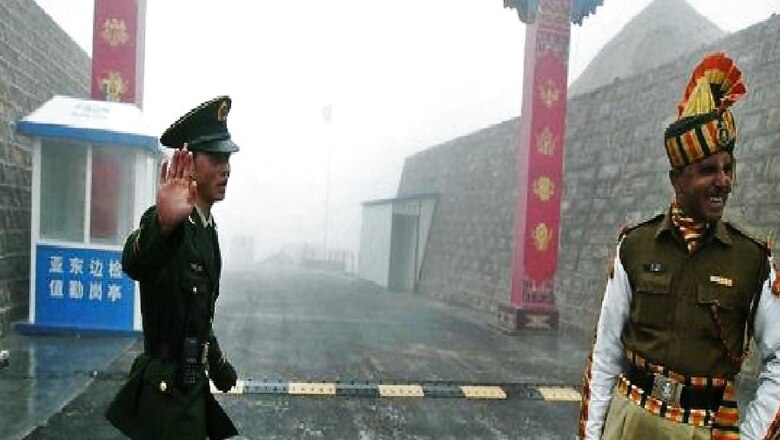
views
“If five lakh people are organised, we can cut off the North-East and India permanently. If not, at least for a month or half-a-month. Throw as much ‘mawad’ (variously described as pus or rubbish) on rail tracks and roads that it takes the Air Force one month to clear it… Cutting off Assam (from India) is our responsibility, only then they (the government) will listen to us. We know the condition of Muslims in Assam… they are being put into detention camps.”
This outlandish threat made by Sharjil Imam, a Shaheen Bagh activist, refers to the Chicken’s Neck. A narrow area in Jalpaiguri, 22 km at its narrowest, Chicken’s Neck is a festering vulnerability close to Bihar; this narrow strip is the sole link to entire North-East from mainland India. A lifeline that controls all troop movements, supplies, logistics, communication, transport to the North-East is a fragile chink in the Indian armour. This narrow strip of land in Jalpaiguri has been on the ISI radar for decades to sow seeds of dissension and terrorism. Acquiring a foothold in this Jalpaiguri territory by the enemy overtly or covertly can hinder supplies to the entire North-East.
In the past decade, a deadly game is being played out in the eastern theatre in plain view. While the government and security agencies have been occupied with internal security considerations of low-intensity conflict and insurgencies in the North-East and Pakistan-sponsored terrorism in Jammu and Kashmir, a significant development has been building up unnoticed, ever so silently.
Along 1,200 km of Bangladesh border, a dangerous sanctuary has been created for terrorists and criminal elements on the Indian side, running from the India-Nepal border through the Purnea area of Bihar along the India-Bangladesh border in states of Bihar and West Bengal by settling a huge number of illegal migrants.
What the ISI conceived as Project Kishanganj has acquired a huge proportion in the shape of Project Eastern Corridor. Starting at foothills of Nepal lakhs of illegal Bangladeshi migrants have been settled in the districts of Kishanganj, Coochbehar, North Dinajpur, South Dinajpur, Malda, Murshidabad, Birbhum, North 24 Parganas, South 24 Parganas right up to Kolkata, changing the demography of these border areas. It passes close to the Pakur area of Jharkhand. Even in the non-border state of Jharkhand, as per the 2011 Census, the Muslim population has gone up to 14% from 8%. It is worth remembering that Nepal is being used as its regional headquarters by the ISI. This Project Eastern Corridor has serious ramifications for national security.
There is an exponential rise in Muslim population largely due to illegal migration in these border areas. The 2011 Census figures are alarming enough, but the situation that obtains on the ground today is scary. Murshidabad and Malda have been overwhelmingly Muslim majority districts for a long time now. Dinajpur and Birbhum are catching up too. Along the length of Eastern Corridor, the entire landscape is dotted with mosques and madrasas. The Uttar Pradesh and Assam governments have, in separate reports sent to the Ministry of Home Affairs, expressed concern over the burgeoning population of Muslims through illegal settlements of Bangladeshis in border areas. The problem is more severe in Bihar and West Bengal, but the governments of Bihar and West Bengal are burying their head in sand and playing vote-bank politics, overlooking serious national security concerns.
The basic premise of counterterrorism strategy is to prevent extremist groups from establishing such a territorial terrorist platform to prevent building up of these safe sanctuary-like spaces, in which terrorists can plot, plan, train, mobilise quickly on a mass scale, if need be, to attack and destabilise the nation at short notice, get logistical support and mingle in the local population free from fear of all interference. Such havens have a boosting impact on the capabilities and aspirations of terrorist groups, providing them with a variety of means that can be leveraged to spread violence and terror. Denying such a terrorist platform, denying these sanctuaries and safe havens is an important cornerstone in countering threats to national security.
The Eastern Corridor has been built for safe and secure quick passage of goods, services, people and contraband. All sorts of Illegal activity is carried out and this corridor provides safe havens for exchange, incubation, hiding of terrorists and provides secluded places, where police and administration find it difficult to reach. Maoists, terrorists and fugitives from law all find refuge here and this corridor is like an impervious human fortress.
Preventing the build-up of this big threat to national security on the eastern frontier should have been a primary concern for the state governments. Unfortunately, their myopic vision could not see beyond the votes these illegal immigrants brought. Voter cards are being promptly issued on arrival for electoral gains by the outfits of the party in power in a sinister politician bureaucratic nexus in West Bengal and Bihar.
Here in the safety of this corridor, terrorist groups such as Lashkar-e-Taiba, Harkat-ul Mujahiddin, Hezbe Islami, Ansarullah Bangla, Harkatul Ansar, to name a few, engage in support activities such as recruiting, training, obtaining finances, communication, etc. without much fear of sustained counterterrorism pressure and action. Usually, terrorists abstain from carrying out attacks in this area for fear of inviting counter-terrorism retaliation and reprisals making the haven unsafe. It is a buffer zone difficult to decriminalise and sanitise where both the Indian and Bangladesh governments find it difficult to flush out terrorist elements.
A peculiar thing about illegal migration from Bangladesh is that it is driven by powerful mafia. These dons control all illegal activity from FICN (fake Indian currency notes), human trafficking, cattle smuggling, drug smuggling, money laundering to illegal migration of Bangladeshis into India. There exist multitudes of worlds hidden in plain sight made up of traffickers, criminals, drug traders, extremists, trained soldiers to suicide bombers, spies and elaborate surveillance systems, a complex intertwined murky underground territory difficult to penetrate.
Raids in connection with Burdwan blasts had showed for the first time that terror is a two-way street now with plans to be executed in Bangladesh being hatched in India and vice-versa, with porous Indo-Bangladesh borders further compounded by multiplicity of enclaves that allow quick and easy movement of terrorists across the borders.
Police being a State subject in the Constitution is a big handicap for central agencies such as the National Investigation Agency (NIA) that face non-cooperation and hostility from State governments. The recent change in law extending the jurisdiction upto 50 km of the border is a step in the right direction.
That the Indian government is taking this threat very seriously is reflected in the exercise going on at a war-footing to create a proposed ninth Union Territory by carving out areas of from Bihar and West Bengal, consisting of 40 constituencies of Bihar and 80 Assembly constituencies of West Bengal that will be directly administered by the Administrator appointed by the president to control the problem of Bangladeshi infiltrators.
Union Home Minister Amit Shah on his recent visit to Jalpaiguri areas gathered information first hand on problem of illegal Bangladeshi migrants. The internal security apparatus is working overtime to find a way to contain it.
Nirmal Kaur is a retired IPS officer of the 1983 batch. Kaur retired as the DGP in Jharkhand. She was in BPRD, MHA till 2016. Views expressed are personal.
Read all the Latest Opinions here

















Comments
0 comment